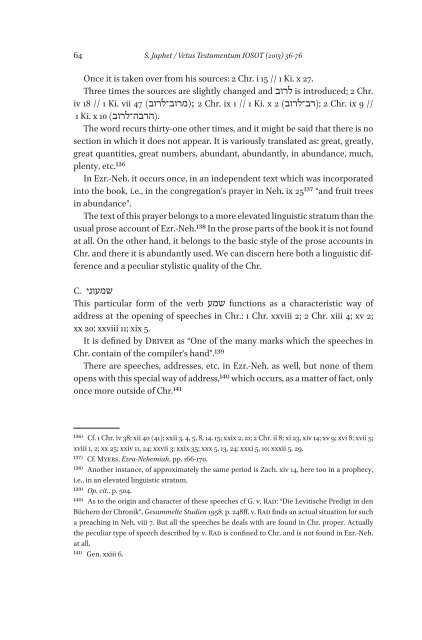Special Issue IOSOT 2013 - Books and Journals
Special Issue IOSOT 2013 - Books and Journals
Special Issue IOSOT 2013 - Books and Journals
Create successful ePaper yourself
Turn your PDF publications into a flip-book with our unique Google optimized e-Paper software.
64 S. Japhet / Vetus Testamentum <strong>IOSOT</strong> (<strong>2013</strong>) 36-76<br />
Once it is taken over from his sources: 2 Chr. i 15 // 1 Ki. x 27.<br />
Three times the sources are slightly changed <strong>and</strong> לרוב is introduced; 2 Chr.<br />
iv 18 // 1 Ki. vii 47 ;)מרוב־לרוב) 2 Chr. ix 1 // 1 Ki. x 2 ;)רב־לרוב) 2 Chr. ix 9 //<br />
.(הרבה־לרוב) 1 Ki. x 10<br />
The word recurs thirty-one other times, <strong>and</strong> it might be said that there is no<br />
section in which it does not appear. It is variously translated as: great, greatly,<br />
great quantities, great numbers, abundant, abundantly, in abundance, much,<br />
plenty, etc.136<br />
In Ezr.-Neh. it occurs once, in an independent text which was incorporated<br />
into the book, i.e., in the congregation’s prayer in Neh. ix 25137 “<strong>and</strong> fruit trees<br />
in abundance”.<br />
The text of this prayer belongs to a more elevated linguistic stratum than the<br />
usual prose account of Ezr.-Neh.138 In the prose parts of the book it is not found<br />
at all. On the other h<strong>and</strong>, it belongs to the basic style of the prose accounts in<br />
Chr. <strong>and</strong> there it is abundantly used. We can discern here both a linguistic difference<br />
<strong>and</strong> a peculiar stylistic quality of the Chr.<br />
שמעוני .C<br />
This particular form of the verb שמע functions as a characteristic way of<br />
address at the opening of speeches in Chr.: 1 Chr. xxviii 2; 2 Chr. xiii 4; xv 2;<br />
xx 20; xxviii 11; xix 5.<br />
It is defined by Driver as “One of the many marks which the speeches in<br />
Chr. contain of the compiler’s h<strong>and</strong>”.139<br />
There are speeches, addresses, etc. in Ezr.-Neh. as well, but none of them<br />
opens with this special way of address,140 which occurs, as a matter of fact, only<br />
once more outside of Chr.141<br />
136) Cf. 1 Chr. iv 38; xii 40 (41); xxii 3, 4, 5, 8, 14. 15; xxix 2, 21; 2 Chr. ii 8; xi 23, xiv 14; xv 9; xvi 8; xvii 5;<br />
xviii 1, 2; xx 25; xxiv 11, 24; xxvii 3; xxix 35; xxx 5, 13, 24; xxxi 5, 10; xxxii 5, 29.<br />
137) Cf. Myers, Ezra-Nehemiah, pp. 166-170.<br />
138) Another instance, of approximately the same period is Zach. xiv 14, here too in a prophecy,<br />
i.e., in an elevated linguistic stratum.<br />
139) Op. cit., p. 504.<br />
140) As to the origin <strong>and</strong> character of these speeches cf G. v. Rad: “Die Levitische Predigt in den<br />
Büchern der Chronik”, Gesammelte Studien 1958. p. 248ff. v. Rad finds an actual situation for such<br />
a preaching in Neh. viii 7. But all the speeches he deals with are found in Chr. proper. Actually<br />
the peculiar type of speech described by v. Rad is confined to Chr. <strong>and</strong> is not found in Ezr.-Neh.<br />
at all.<br />
141) Gen. xxiii 6.








![Am HaSefer [Volk des Buches] - Books and Journals](https://img.yumpu.com/20648352/1/174x260/am-hasefer-volk-des-buches-books-and-journals.jpg?quality=85)







